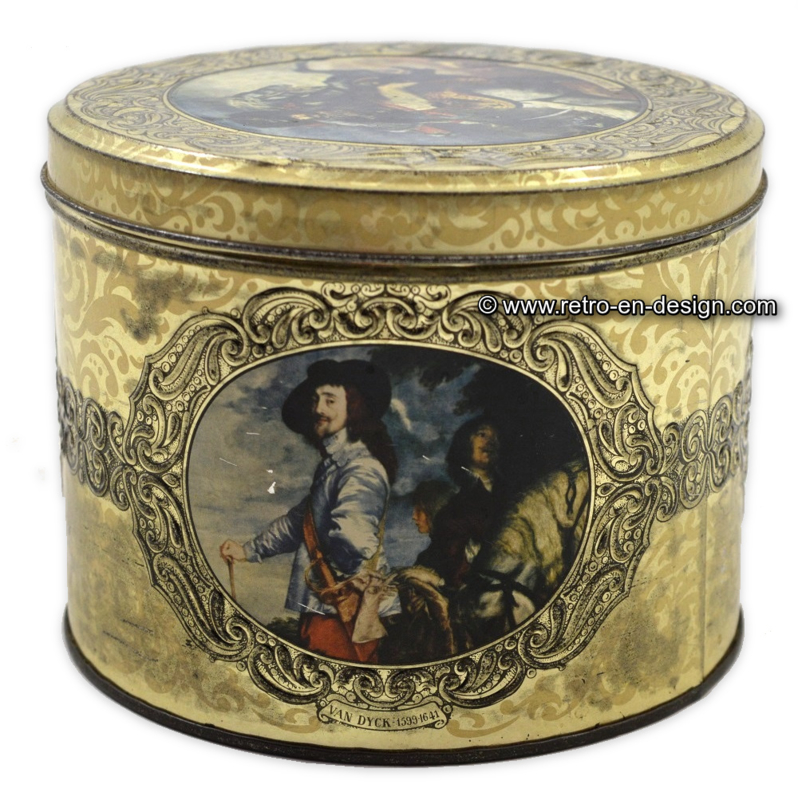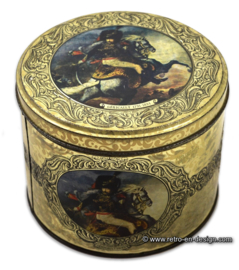A R C H I V E
Vintage Doria cookie tin with reproductions of Géricault, Gros and Van Dyck
SKU: 1140Vintage tin with reproductions of Géricault, Gros and Van Dyck.
Very decorative round biscuit tin by Doria, Italy. Decorated all around with various reproductions of famous painters. This tin is equipped with a separate loose lid. The lid and sides have embossed details. Marked with Doria at the bottom.
This tin has reproductions of:
Giericault - Hunter of the Garde.
Gros - Bonaparte at the bridge of Arcole.
Van Dyck - Charles I, king of England during the hunt.
- Height: 14 cm.
- Diameter: 17,8 cm.
Théodore Géricault
Jean-Louis André Théodore Géricault 26 September 1791 – 26 January 1824) was an influential French painter and lithographer, known for The Raft of the Medusa and other paintings. Although he died young, he was one of the pioneers of the Romantic movement.
Born in Rouen, France, Géricault was educated in the tradition of English sporting art by Carle Vernet and classical figure composition by Pierre-Narcisse Guérin, a rigorous classicist who disapproved of his student's impulsive temperament while recognizing his talent. Géricault soon left the classroom, choosing to study at the Louvre, where from 1810 to 1815 he copied paintings by Rubens, Titian, Velázquez and Rembrandt.
During this period at the Louvre he discovered a vitality he found lacking in the prevailing school of Neoclassicism. Much of his time was spent in Versailles, where he found the stables of the palace open to him, and where he gained his knowledge of the anatomy and action of horses.
Antoine-Jean Gros
Antoine-Jean Gros (16 March 1771 – 25 June 1835), titled as Baron Gros in 1824, was a French painter. His work was in the genres of history and neoclassical painting.
Gros studied under Jacques-Louis David in Paris and began an independent artistic career during the French Revolution. Forced to leave France, he moved to Genoa and witnessed the nearby Battle of Arcole (1796). Inspired by an event during the battle, he produced a portrait of the French commander, Napoleon Bonaparte, then a newly promoted general. The portrait brought Gros to public attention and gained the patronage of Napoleon.
After traveling with Napoleon's army for several years, he returned to Paris in 1799. Gros produced several large paintings of battles and other events in Napoleon's life. These were mostly in a neoclassical style, but Napoléon on the Battlefield of Eylau adopted a more realistic portrayal of the horrors of war. Gros also painted portraits of officers in the French army and members of French high society. After the fall of Napoleon, he shifted his artistic focus and produced more history paintings, which art historians regard as less impressive than his earlier work
Antoon van Dyck
Sir Anthony van Dyck many variant spellings (22 March 1599 – 9 December 1641) was a Flemish Baroque artist who became the leading court painter in England, after enjoying great success in Italy and the Southern Netherlands. He is most famous for his portraits of Charles I of England and his family and court, painted with a relaxed elegance that was to be the dominant influence on English portrait-painting for the next 150 years. He also painted biblical and mythological subjects, displayed outstanding facility as a draughtsman, and was an important innovator in watercolour and etching. The Van Dyke beard is named after him.
Some translations come from an automated system and may contain errors.























